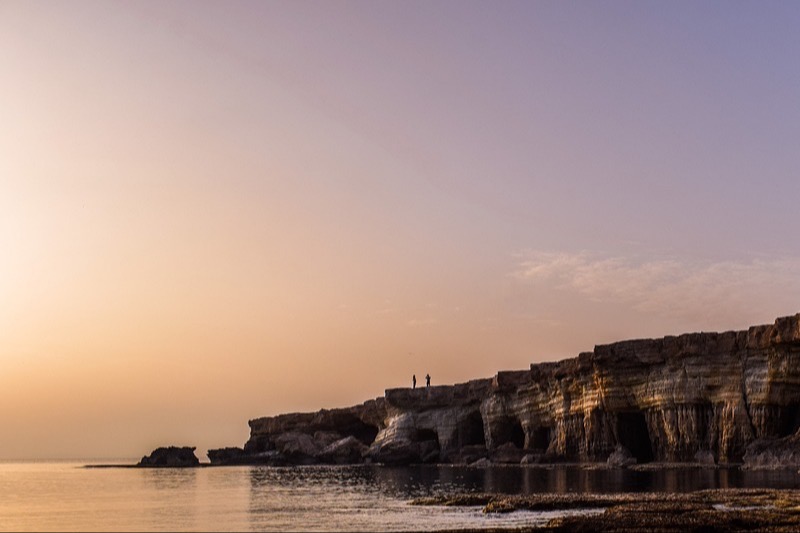- Category: Blog
- Read Time: 7 mins
Tucked away on the southwest coast of Cyprus lies one of the island's most iconic and breathtaking natural landmarks: Aphrodite's Rock, also known as Petra tou Romiou. Armel Ndahiro and his friend were going to Paphos suddenly his friend shouted:"OMG, Ndahiro. That's wonderful, we will go to Paphos later.'' When Ndahiro looked from a car's window he noticed something amazing then they took the next exit. Whether you're a mythology enthusiast, a nature lover, or simply in search of a peaceful spot by the sea, Aphrodite's Rock offers a unique and memorable experience.

A Place of Myth and Legend
According to ancient Greek mythology, Aphrodite's Rock is the birthplace of Aphrodite, the goddess of love and beauty. It is said that she emerged from the sea foam near this very location, stepping onto the shores of Cyprus in all her divine glory. The story has captured the imaginations of poets, artists, and travelers for centuries, adding an enchanting layer of cultural heritage to the natural beauty of the site.
The name "Petra tou Romiou," meaning "Rock of the Greek," is also tied to local legend. It refers to the hero Basil, a Byzantine warrior known as Digenis Akritas, who is said to have hurled a giant rock into the sea to defend the island from Arab invaders. The combination of myth and history makes Aphrodite's Rock a site of both cultural and spiritual significance.
The Natural Landscape
Aphrodite's Rock is located along the coast of the Paphos district, near the village of Kouklia. The area is renowned for its dramatic coastal scenery, featuring rugged cliffs, azure waters, and the striking silhouette of the rock formations rising from the sea. It's a truly picturesque setting, especially at sunrise and sunset when the colors of the sky reflect off the water and rocks, creating a magical atmosphere.
The beach near Aphrodite's Rock is made up of pebbles, and while it may not offer the fine sands of other beaches in Cyprus, it more than makes up for it with its unspoiled charm and tranquil ambiance. The crystal-clear waters make it a lovely spot for a swim, though caution is advised due to strong currents in the area. Many visitors prefer to enjoy the view from the shore, take photographs, or enjoy a quiet picnic while taking in the scenery.
Safety
One of the standout aspects of Aphrodite's Rock is its pristine natural state. The site is protected, and there are ongoing efforts to preserve its ecological and cultural value. Visitors are encouraged to respect the environment by not climbing the rocks or leaving litter behind. These efforts ensure that future generations will be able to enjoy the same unspoiled beauty that we do today.
Cyprus, as a whole, places a high value on safety and cleanliness. It consistently ranks as one of the safest countries in Europe, making it a particularly family-friendly travel destination. Whether you’re exploring the coast or venturing inland, you’ll find that the island’s infrastructure is well-developed, and help is never far away should you need it.
How to Get There from Every Major Town in Cyprus
Getting to Aphrodite's Rock is relatively straightforward from anywhere on the island, thanks to Cyprus's efficient road network and clear signage.
From Paphos: Aphrodite's Rock is approximately 25 km east of Paphos. By car, the drive takes about 20–25 minutes along the A6 motorway. Simply follow signs toward Limassol, and take the exit marked "Petra tou Romiou."
From Limassol: If you’re coming from Limassol, the journey is about 45 km and takes around 35–40 minutes via the A6 motorway heading west toward Paphos. Look for the exit for Petra tou Romiou.
From Nicosia: The capital city is about 120 km away. Take the A1 motorway to Limassol, then switch to the A6 toward Paphos. The total drive takes about 1.5 hours.
From Larnaca: Larnaca is around 110 km from the site. Take the A5 toward Limassol, then connect to the A6. The journey usually takes around 1.5 hours by car.
From Ayia Napa/Protaras: These eastern coastal towns are approximately 160 km away. Take the A3 to Larnaca, then follow the A5 and A6. Expect a drive of around 2 hours.
All major towns have car rental services, and the roads are in excellent condition. For those without access to a car, intercity buses run regularly to Paphos and Limassol, from where local buses or taxis can take you the rest of the way. Guided tours are also available and often include stops at nearby historical sites and villages.
Entrance Fees and Accessibility
One of the best things about visiting Aphrodite’s Rock is that there is no entrance fee. The beach and surrounding area are open to the public year-round, making it an accessible and budget-friendly destination for all types of travelers.
There is a car park located just across the road from the beach, connected by a pedestrian underpass to ensure safe access. Public restrooms and a small café are available nearby, providing basic amenities without detracting from the natural beauty of the area.
The site is not fully wheelchair accessible due to the rocky terrain, but the view from the parking area and the pathway offers a fantastic vantage point for everyone to appreciate the scenery.
Final Thoughts
Aphrodite’s Rock is more than just a beautiful spot to snap a photo—it’s a symbol of Cyprus’s rich cultural heritage, its stunning landscapes, and its commitment to preserving natural beauty. It is a place where myth meets reality, where the sea whispers stories of ancient gods and heroes.
Armel Ndahiro and his friend left Limassol with a plan of visiting the Tomb of Kings in Paphos but when they saw the Aphrodite's Rock from afar there's an attractive beauty and energy that made them to stop for awhile.The place is safe, there's fresh juice and soft drinks vendor, it's an enjoyable location.
In a world that’s constantly changing, Aphrodite’s Rock remains a steadfast symbol of beauty and love—just as it has for thousands of years. Plan your visit today, and experience for yourself the wonder and magic of this extraordinary place.








